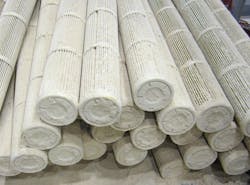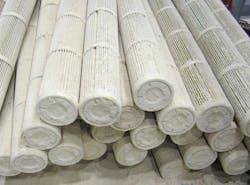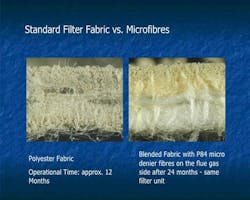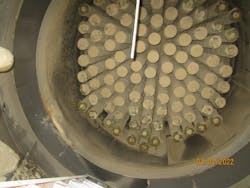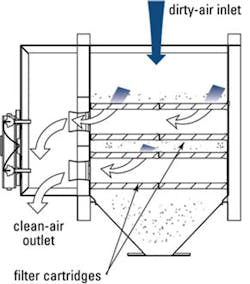Filter selection criteria for dry dust collection systems
Key Takeaways:
- Dust collector filter selection begins with an understanding of the dust's characteristics.
- Process factors for filter selection include emissions requirements, collector size and location, material loading, and air-to-cloth ratio.
- Challenging dusts require lower air velocities through the filters, and insufficient filter area will lead to costly maintenance problems and poor performance.
Selecting the appropriate filter for a dry dust collection system is a critical decision that directly impacts operational efficiency, plant safety, and long-term maintenance costs. Key factors include both dust characteristics and process constraints, and both bag and cartridge filters have advantages and limitations in various scenarios. While this is not intended to be an exhaustive explanation, the following practical insights will help engineers and facility managers make informed choices tailored to their specific dust collection needs.
Material characteristics
Selecting the type of filter best suited for a dust collection system begins with a thorough understanding of the pertinent characteristics of the dusts being collected and filtered. These characteristics include but are not limited to moisture, oil and/or fat content, temperature, whether the material is cohesive and/or adhesive, particle size, and distribution percentages.
For example, pleated cartridge filters should not be used with higher moisture and/or oily/fatty dusts (such as certain food dusts) as the dust will tend to fill the pleats (Figure 2). Bag filters with coatings designed for these characteristics are best suited for this application.
A second example would be higher temperature dusts and air/gas flow near or above 180°F. Standard cartridges are typically limited to 180°F and are a poor selection for higher temperature dusts. While higher temperature cartridges are available, their high cost and the limited filter area generally render their use impractical. Again, in this situation, properly selected bag filters would be the best solution.
A third example is the dust’s cohesive and/or adhesive properties. Typically, cartridges are not the best selection for cohesive or adhesive materials as the particles tend to agglomerate in the V portion of the pleats, eventually rendering the cartridges useless. Properly selected bag filters designed for such materials would be the best choice.
Bag versus cartridge filters
The examples in the previous section do not mean there is no place for cartridge filters. For dry dusts with significant fractions of small particle sizes, atmospheric temperatures, and only mildly cohesive and/or adhesive particles, cartridge filters may be the best selection. Although the amount of cartridge filter area would be an additional important factor.
Bag filters can be used for almost all requirements but have distinct disadvantages compared to cartridge filters (e.g., the number of filters required, bag cages, filter replacement time, etc.). Until recently, cartridge filters were the optimal selection for high fractions of sub-5-micron, and especially sub-micron, dusts (such as carbon blacks, highly milled materials, etc.). However, with the advent of micro-denier filter media, ultra-fine particle separation performance with bag filters can now equal that of cartridge filters while still allowing for other difficult dust characteristics (Figure 3).
Emissions requirements
After material characteristics, proper filter selection must consider the emission allowance or standard that must be achieved for permitting by regulatory agencies. This is typically stated in grams per cubic meter or cfm. Properly selected cartridge and bag filters can currently achieve any known emission requirement, whether state or federal; however, other factors (discussed later in the article) must also be considered, such as the fraction of sub-micron dusts and other dust characteristics.
Dust collector size and location
The third consideration for proper filter selection concerns the physical size and location of the dust collector. This includes accessibility for maintenance and various operational requirements. As a rule of thumb, when headroom is severely limited, side-access cartridge filters may be the best solution due to costs and physical floor space. When using top-access bag filters to achieve the desired filter area for the application, filters measuring 8 feet or longer are often necessary. This requires significantly more headroom than cartridge filters for the same effective filter area. Side-access (i.e., dirty air plenum) bag filters are available but are more difficult, and in some cases more dangerous (e.g., combustible dusts and confined space), than top-access or external side-access filters (envelop bag or cartridge).
Material loading
Another equally important factor in filter selection is material loading, or the rate of material entering the dust collector and then reaching the filters. This value can be difficult to determine for a typical dust collection system as it is dependent upon the rate of dusts generated at the system’s dust sources. However, there are practical limits of material rates (i.e., loading) which require direct filtration. In my experience, the maximum material rates at the filters are in the range of 5 to 6 grains per cubic foot of airflow (7,000 grains per pound). For a 10,000 acfm dust collection system, this would convert to a filter material loading rate of approximately 7 to 8.6 pounds per minute. It is important to keep in mind that this is amount of material constantly “at” the filters and not necessarily the rate entering the dust collector.
This rate is high as it converts to 420 to over 500 pounds per hour. Most true dust collection systems would not exceed and are typically well below this rate.
However, pneumatic conveying system filter receivers (which are essentially cylindrical dust collectors) often filter tons of material per hour. Typically, these material loads are achieved by separating most of the material (usually the larger particles) before they rise up (or fall down) to the filters. This can be done by using a tangential inlet section (cyclonic separation) or radial inlet baffles (impact separation).
For practical consideration, cartridge filters are not typically the best solution for higher material loads (especially for downflow collector designs). Bag filters tend to filter higher material loads better than cartridge filters.
Interstitial dust velocity
Another important consideration is the interstitial or rising velocity of the dusts inside the dust collector up between the filters. This is applicable to vertical filter bag and cartridge dust collectors. The incoming air would rise from the inlet up to and between the filters (Figure 4). This does not apply to true downflow dust collectors (Figure 5). If the airflow velocity between the filters (i.e., interstitial velocity) is sufficient to keep fine dust particles airborne between the filters, the loading on the filters becomes excessive. This results in the filters not being able to clean properly and leads to premature filter failure and lowered airflow through the system. This condition can also cause significant problems with the method used to discharge the collected material from the dust collector.
The allowable interstitial velocity (calculated by subtracting the cross section of all the filters from the cross section of the enclosure and divided into the incoming air volume) is highly dependent upon the material characteristics. Ultra-fine and light dusts, such as carbon black, silicates, sander dust, and similar materials, will stay airborne with velocities below 200 fpm, while some food and mineral dusts with higher densities will require velocities well over 200 fpm. Therefore, common sense, historical information, and material characteristics will have to be considered when evaluating the issues associated with interstitial velocity.
Particle size
Another significant issue for filter selection concerns the particle sizes being filtered. Dusts that have a significant percentage of particles smaller than 2 microns represent a particularly difficult problem. In the author’s opinion, assuming typical material loadings, a 2 micron or less percentage of one percent (of the incoming material rate) would be considered a high value. If that same one percent is 1 micron, or smaller, then the problem increases significantly.
Standard polyester filter bags have trouble, even with proper precoating, filtering particles 2 microns and smaller. This becomes exacerbated the longer the filter is in use. Obviously, this situation would be worse for 1 micron and smaller particles. For significant percentages of small particles, the author recommends either cartridge filters or Micro Denier based bag filters. Both types of filters are typically capable of meeting emission standards under these conditions.
It is important to note, however, that dust particles below 0.5 microns are very difficult to separate from the airflow. Even with cartridges or denier filters some sub-micron particle emissions will occur (often only detectable by coloring of the fan discharge as they are not normally visible).
Air-to-cloth ratio
While air-to-cloth ratio is critical to proper dust collector filter selection, it is one of the most misunderstood factors influencing filter selection. A quick search of the internet will result in many articles on the subject, but confusion and misinformation still exist.
Air-to-cloth (or air-to-filter-media) ratio simply refers to the ratio between the maximum actual airflow through a dust collector (ACFM) and the amount of filter surface area available in the dust collector. Dividing the ACFM by the filter surface area (in sq. ft.) results in FPM or the actual air velocity through the filter. The higher this velocity (air-to-cloth ratio) the more likely there will be problems with the filters (such as premature filter failure).
Recommendations for dust collector and filter selection
The following recommendations are based on decades of experience and the evaluation of hundreds of dust collection (and related) systems. These recommendations may be considered conservative but will also likely result in a successful selection of the correct dust collector and filter for the application.
Dusts that have negative characteristics (cohesive, adhesive, moist, oily, high percentage of smaller particle sizes, etc.) require lower filter velocities (i.e. air-to-cloth ratios). The type of filter media used will also significantly affect the correct filter velocity.
For bag dust collectors (all types of media), a filter velocity of 5 fpm or less should be used for difficult dusts, while velocities up to 6 fpm can be used for easier-to-filter dusts. For cartridge dust collectors, whether downflow or vertical filters, the value should be 1.5 fpm or less. For very difficult materials (such as carbon black), a filter velocity of 1.0 fpm or less may be needed.
Vendors may claim the ability to significantly exceed these values, but experience has proven this range of values to be generally valid. The person responsible for the system’s performance should do more than think twice about accepting sales-oriented claims about filter capacity. Insufficient filter area will lead to costly maintenance problems and poor performance down the road. More than sufficient filter area, on the other hand, will not lead to operational problems with the system. In more than 50 years in the industry, not once has a customer complained about a dust collector having too much filter area.
Filter length is another significant consideration. There are limits to the length of both bag and cartridge filters due to the decreasing ability of automatic filter-cleaning systems — whether they are compressed-air pulse-jet or reverse-air-pulse (positive displacement blower) — to provide the necessary pressure and airflow to successfully clean further down the length of a long filter.
Also, the type of filter makes a significant difference in the practical length that can be successfully cleaned. Bag filters are easier to clean than cartridge filters because pleated cartridges are stiffer (more resistant) and have smaller pathways for the reversed pulses of cleaning air to flow through.
The practical maximum length of a vertical cartridge filter is 40 inches (approximately 1 meter). The practical maximum length of a bag filter is 10 feet, although some easy-to-clean materials can use filters up to 12 feet long.
Finally, the amount of pressure and air volume is a factor in filter cleaning. For example, side-loading cartridge filters typically require more airflow at compressed air pressures to successfully clean the filters, while vertical cartridge filters typically require standard compressed airflow and pressure similar to that required by bag filters.
About the Author

Jack Osborn
Senior Project Engineer
Jack Osborn is senior project engineer at Airdusco EDS and a member of Processing’s editorial advisory board. He has more than 50 years of experience in dust collection systems, centralized vacuum cleaning systems, pneumatic conveying systems, and all types of bulk handling systems. He has either designed or evaluated (e.g., engineering studies/audits, performance testing, etc.) more than 2,000 dust collection systems during his career and is a participating member of all six NFPA combustible dust committees.
